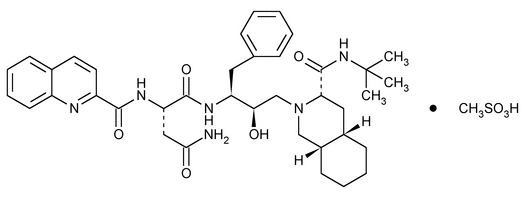Saquinavir Mesylate
(sa kwin' a vir mes' i late).
C38H50N6O5·CH4O3S




 766.96
766.96
Butanediamide, N1-[3-[3-[[(1,1-dimethylethyl)amino]carbonyl]octahydro-2(1H)-isoquinolinyl]-2-hydroxy-1-(phenylmethyl)propyl]-2-[(2-quinolinylcarbonyl)amino]-, [3S-[2[1R*(R*),2S*],3 ,4a
,4a ,8a
,8a ]]-, monomethanesulfonate (salt).
]]-, monomethanesulfonate (salt).
(S)-N-[( S)-
S)- -[(1R)-2-[(3S,4aS,8aS)-3-(tert-Butylcarbamoyl)octahydro-2(1H)-isoquinolyl]-1-hydroxyethyl]phenethyl]-2-quinaldamidosuccinamide monomethanesulfonate (salt)
-[(1R)-2-[(3S,4aS,8aS)-3-(tert-Butylcarbamoyl)octahydro-2(1H)-isoquinolyl]-1-hydroxyethyl]phenethyl]-2-quinaldamidosuccinamide monomethanesulfonate (salt)


 [149845-06-7].
[149845-06-7].
Butanediamide, N1-[3-[3-[[(1,1-dimethylethyl)amino]carbonyl]octahydro-2(1H)-isoquinolinyl]-2-hydroxy-1-(phenylmethyl)propyl]-2-[(2-quinolinylcarbonyl)amino]-, [3S-[2[1R*(R*),2S*],3
(S)-N-[(
» Saquinavir Mesylate contains not less than 98.5 percent and not more than 101.0 percent of C38H50N6O5·CH4O3S, calculated on the anhydrous basis.
Packaging and storage—
Preserve in tight containers, and store at controlled room temperature.
Identification—
B:
Ultraviolet Absorption  197U
197U —
—
Solution:
12 µg per mL.
Medium:
methanol.
The absorptivity of the sample preparation at 238 ± 2 nm, calculated on the anhydrous basis, is between 61.0 and 63.4.
C:
The retention time of the major peak in the chromatogram of the Assay preparation corresponds to that in the chromatogram of the Standard preparation, as obtained in the Assay.
Specific rotation  781S
781S :
between
:
between  66.8
66.8 and
and  69.6
69.6 (
( = 436 nm at 20
= 436 nm at 20 ).
).
Test solution:
5 mg per mL, in methanol.
Water, Method I  921
921 :
not more than 1.0%.
:
not more than 1.0%.
Residue on ignition  281
281 :
not more than 0.1%.
:
not more than 0.1%.
Heavy metals, Method II  231
231 —The limit is 0.001%.
—The limit is 0.001%.
Chromatographic purity—
Triethylamine phosphate solution, Mobile phase, System suitability solution, and Chromatographic system—
Proceed as directed in the Assay.
Standard solution—
Use the Standard preparation, prepared as directed in the Assay.
Test solution—
Use the Assay preparation.
Procedure—
Separately inject equal volumes (about 20 µL) of the Standard solution and the Test solution into the chromatograph, record the chromatograms, and measure the peak responses. Calculate the percentage of each impurity in the portion of Saquinavir Mesylate taken by the formula:
100F(CS /CU)(ri / rS)
in which F is a response factor and is equal to 2 for peaks, if present, at a retention time of 0.32 relative to saquinavir, to 0.5 for peaks, if present, at retention times of about 0.38 and 0.53 relative to saquinavir, and to 1 for all other peaks; CS is the concentration, in mg per mL, of USP Saquinavir Mesylate RS in the Standard solution; CU is the concentration, in mg per mL, of Saquinavir Mesylate in the Test solution; ri is the peak response for each impurity obtained from the Test solution; and rS is the peak response for saquinavir obtained from the Standard solution: not more than 0.1% of any individual impurity is found; and not more than 0.5% of total impurities is found.
Assay—
Triethylamine phosphate solution—
Transfer 10 mL of triethylamine to a 1-liter volumetric flask, dilute with water to volume, and mix. Adjust with phosphoric acid to a pH of 2.5, and filter.
Mobile phase—
Prepare a filtered and degassed mixture of Triethylamine phosphate solution, tetrahydrofuran, and acetonitrile (14:5:1). [note—Protect from light. ] Make adjustments if necessary (see System Suitability under Chromatography  621
621 ).
).
System suitability solution—
Dissolve suitable quantities of USP Saquinavir Related Compound A RS and USP Saquinavir Mesylate RS in Mobile phase to obtain a solution containing about 2 µg per mL and 0.25 mg per mL, respectively.
Standard preparation—
Dissolve an accurately weighed quantity of USP Saquinavir Mesylate RS in Mobile phase, and dilute quantitatively, and stepwise if necessary, with Mobile phase to obtain a solution having a known concentration of about 0.25 mg per mL.
Assay preparation—
Transfer about 12.5 mg of Saquinavir Mesylate, accurately weighed, to a 50-mL volumetric flask, dissolve in and dilute with Mobile phase to volume, and mix for about 20 minutes.
Chromatographic system (see Chromatography  621
621 )—
The liquid chromatograph is equipped with a 210-nm detector and a 4.6-mm × 25-cm column that contains packing L1. The column temperature is maintained at 20
)—
The liquid chromatograph is equipped with a 210-nm detector and a 4.6-mm × 25-cm column that contains packing L1. The column temperature is maintained at 20 , and the flow rate is about 1 mL per minute. Chromatograph the System suitability solution, and record the peak responses as directed for Procedure: the relative retention times are about 0.89 for saquinavir related compound A and 1.0 for saquinavir; and the resolution, R, between saquinavir related compound A and saquinavir is not less than 1.5. Chromatograph the Standard preparation, and record the peak responses as directed for Procedure: the column efficiency is not less than 500 theoretical plates; and the relative standard deviation for replicate injections is not more than 2.0%.
, and the flow rate is about 1 mL per minute. Chromatograph the System suitability solution, and record the peak responses as directed for Procedure: the relative retention times are about 0.89 for saquinavir related compound A and 1.0 for saquinavir; and the resolution, R, between saquinavir related compound A and saquinavir is not less than 1.5. Chromatograph the Standard preparation, and record the peak responses as directed for Procedure: the column efficiency is not less than 500 theoretical plates; and the relative standard deviation for replicate injections is not more than 2.0%.
Procedure—
Separately inject equal volumes (about 20 µL) of the Standard preparation and the Assay preparation into the chromatograph, record the chromatograms, and measure the responses for the major peaks. Calculate the quantity, in mg, of C38H50N6O5·CH4O3S in the portion of Saquinavir Mesylate taken by the formula:
50C(rU / rS)
in which C is the concentration, in mg per mL, of USP Saquinavir Mesylate RS in the Standard preparation; and rU and rS are the peak responses obtained from the Assay preparation and the Standard preparation, respectively.
Auxiliary Information—
Please check for your question in the FAQs before contacting USP.
| Topic/Question | Contact | Expert Committee |
|---|---|---|
| Monograph | Leonel M. Santos, Ph.D.
Senior Scientific Liaison 1-301-816-8168 |
(SM12010) Monographs - Small Molecules 1 |
| Reference Standards | RS Technical Services 1-301-816-8129 rstech@usp.org |
USP35–NF30 Page 4608
Pharmacopeial Forum: Volume No. 33(5) Page 940

